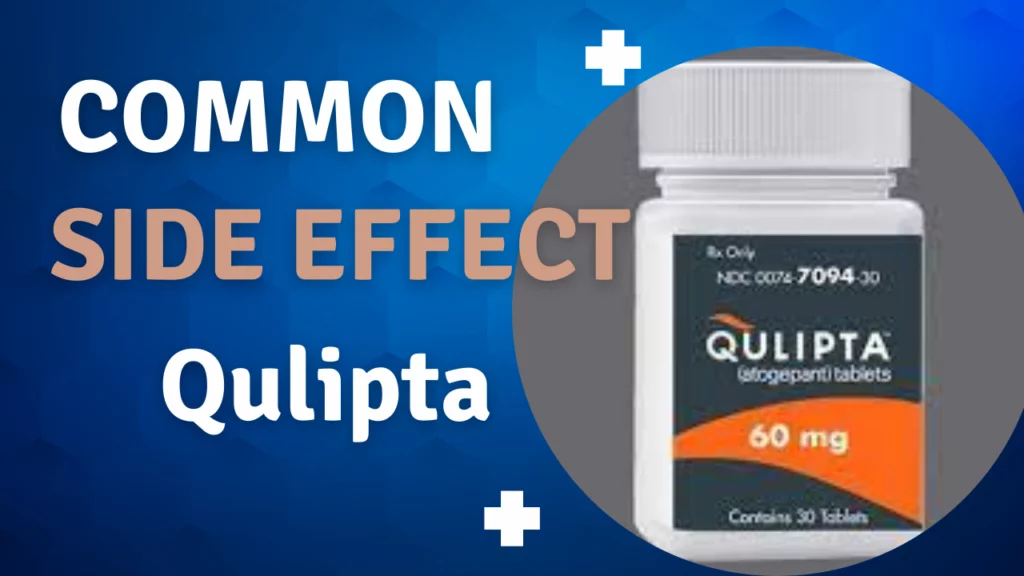Qulipta is a prescription drug used to prevent migraine attacks in adults. It contains the active ingredient atonement, which belongs to a class of drugs called CGRP inhibitors. Qulipta works by blocking the activity of a protein called CGRP, which is involved in migraine pain and inflammation. Qulipta can cause some side effects, ranging from mild to serious. This article will explain Qulipta side effects and how to manage them.
Common side effects of Qulipta

Some of the most common side effects of Qulipta are:
- Nausea. This is a feeling of sickness or discomfort in the stomach that may make you want to vomit. Nausea was reported by 9% of people taking Qulipta 60 mg once daily, compared to 4% of people taking a placebo (a sugar pill with no active drug). To prevent or reduce nausea, you can try taking Qulipta with food or water, avoiding spicy or greasy foods, and eating smaller meals more frequently. You can also ask your doctor about anti-nausea medications if needed.
- Constipation. This is when you have difficulty passing stools or have fewer bowel movements than usual. Constipation was reported by 7% of people taking Qulipta 60 mg once daily, compared to 2% of people taking a placebo. To prevent or relieve constipation, you can drink plenty of fluids, eat more fiber-rich foods such as fruits, vegetables, and whole grains, and exercise regularly. You can also ask your doctor about laxatives or stool softeners if needed.
- Fatigue. This is when you feel tired, weak, or low on energy. Fatigue was reported by 6% of people taking Qulipta 60 mg once daily, compared to 3% of people taking a placebo. To cope with fatigue, you can try to get enough sleep, rest when you need to, avoid alcohol and caffeine, and eat a balanced diet. You can also talk to your doctor about adjusting your dose or schedule of Qulipta if fatigue interferes with your daily activities.
Other common side effects of Qulipta include:
- Decreased appetite
- Weight loss
- Increased liver enzyme levels
These side effects are usually mild and temporary and may go away as your body adjusts to the medication. However, if they persist or bother you, you should talk to your doctor or pharmacist. Do not stop taking Qulipta without your doctor’s advice.
Serious side effects of Qulipta

Serious side effects of Qulipta are rare, but they can occur. Some examples are:
- Allergic reaction. This is when your body reacts to a substance that it considers harmful, such as a drug or food. Symptoms of an allergic reaction may include rash, itching, swelling, hives, trouble breathing or swallowing, or shock (a sudden drop in blood pressure). An allergic reaction can be life-threatening and requires immediate medical attention. If you have any signs of an allergic reaction while taking Qulipta, stop taking it and go to the nearest emergency room.
- Liver damage. This is when your liver becomes inflamed or injured due to various causes, such as infection, alcohol abuse, or certain drugs. Symptoms of liver damage may include yellowing of the skin or eyes (jaundice), dark urine, light-colored stools, nausea, vomiting, loss of appetite, abdominal pain or swelling, or fatigue. Liver damage can be serious and lead to liver failure or death if not treated promptly. Qulipta can cause increased liver enzyme levels in some people, which may indicate liver damage. Your doctor will monitor your liver function before and during your treatment with Qulipta. If you have any signs of liver damage while taking Qulipta, stop taking it and contact your doctor right away.
Qulipta may cause other serious side effects that are not listed here. If you experience any unusual or severe symptoms while taking Qulipta, contact your doctor immediately.
How to report side effects
If you have any side effects from taking Qulipta, you should report them to your doctor or pharmacist. You can also report them to the Food and Drug Administration (FDA) through their MedWatch program. This helps the FDA monitor the safety and effectiveness of drugs and inform the public about any potential risks.
How to take Qulipta
Qulipta comes as a tablet that you swallow once a day. You can take it with or without food but try to take it at the same time each day. Follow the directions on your prescription label, and do not take more or less than prescribed.
Qulipta is not meant to treat a migraine attack that has already started. It is only used to prevent migraine attacks from occurring. If you have a migraine attack while taking Qulipta, you can use another medication that your doctor has prescribed for acute treatment.
Do not stop taking Qulipta without talking to your doctor first. Stopping Qulipta suddenly may cause your migraine attacks to come back or worsen. If you need to stop taking Qulipta, your doctor will tell you how to do so gradually and safely.
If you miss a dose of Qulipta, take it as soon as you remember. But if it is almost time for your next dose, skip the missed dose and take your next dose at the regular time. Do not take two doses at the same time to make up for a missed dose.
If you take too much Qulipta, call your doctor or poison control center right away. You may experience symptoms such as nausea, vomiting, drowsiness, or headache.
Who should not take Qulipta
Qulipta is not for everyone. You should not take Qulipta if you:
- Are allergic to atogepant or any of the ingredients in Qulipta
- Have severe liver problems or liver failure
- Are pregnant or plan to become pregnant
- Are breastfeeding or plan to breastfeed
Qulipta may interact with other drugs that you are taking, especially those that affect the liver or the levels of CGRP in your body. Tell your doctor about all the medications, supplements, and herbal products that you use before starting Qulipta. Do not start or stop any other drugs without your doctor’s approval.
Qulipta may also affect certain medical conditions that you have or may develop in the future. Tell your doctor if you have or have had:
- Liver problems
- Kidney problem
- High blood pressure
- Diabetes
- Depression
- Seizures
Your doctor will decide if Qulipta is safe and effective for you based on your medical history and current condition.
FAQS
Is it possible to take Qulipta as needed?
Oral administration of 50 mg or 100 mg is the suggested dosage, as needed.
What is the duration of Qulipta’s effectiveness?
In the first 1 to 7 days of treatment, Qulipta can start to help avoid migraine headaches. On the first day and first week following treatment, patients reported having fewer migraines. It can take up to 12 weeks of daily treatment to see full benefits.
Conclusion
Qulipta can cause some side effects, ranging from mild to serious. Qulipta is a new drug that can help prevent migraine attacks in adults. It works by blocking the activity of CGRP, a protein that causes migraine pain and inflammation. Qulipta can cause some side effects, such as nausea, constipation, and fatigue, but they are usually mild and temporary. Qulipta can also cause serious side effects, such as allergic reactions and liver damage, but they are rare. You should report any side effects that you experience to your doctor or pharmacist. You should also follow your doctor’s instructions on how to take Qulipta safely and effectively.

